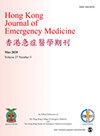香港重症监护室收治的热相关疾病患者:一项单中心回顾性研究(2009-2020)
IF 0.8
4区 医学
Q4 EMERGENCY MEDICINE
引用次数: 0
摘要
简介:在香港,热相关疾病(HRI)是夏季从事户外活动的健康成年人发病和死亡的重要原因。它可能导致重症监护病房(ICU)的入院。本回顾性研究旨在分析重症HRI患者,并确定潜在的死亡危险因素。方法:本回顾性病例系列包括2009年1月1日至2020年6月30日在东部尤德夫人那打素医院(PYNEH) ICU住院的成人HRI患者。分析了人口统计学、入院严重程度、合并症和实验室调查。研究的结局数据包括死亡率、ICU住院时间(LOS)、呼吸机天数和医院LOS。结果:在纳入的38个人中,97%是徒步旅行者。92.1%的患者存活,7.9%的患者死亡。患者的中位年龄为48岁,78.9%为男性。高血压是最常见的并发疾病。大多数病例出现在炎热的夏季5月(29%)、7月(24%)和8月(18%)。各地区的平均峰值温度和湿度分别为33.2°C和88%。92%的病人被直升机空运到医院。体温峰值中位数为40.3°C。中枢神经系统紊乱(格拉斯哥昏迷量表(GCS)评分≥8)是最高的表现特征(65.7%)。约57.9%的患者需要血管加压药物支持,其次是机械通气(50%)和肾脏替代治疗(31.6%)。结论:重症HRI患者以徒步旅行者和中年人居多。尽管在ICU进行了高级生命支持,但死亡率为7.9%。提高公众对炎热夏季徒步旅行相关风险的认识对于预防HRI至关重要。本文章由计算机程序翻译,如有差异,请以英文原文为准。
Patients with heat-related illness admitted to an intensive care unit in Hong Kong: A single-centre retrospective study (2009–2020)
Introduction: In Hong Kong, heat-related illness (HRI) represents an important cause of morbidity and mortality among healthy adults engaging in outdoor activities during summer. It can result in intensive care unit (ICU) admission. This retrospective study aimed to profile critically ill patients with HRI and identify potential risk factors for mortality. Methods: This retrospective case series included adults with HRI from 1 January 2009 to 30 June 2020 admitted to the ICU of Pamela Youde Nethersole Eastern Hospital (PYNEH). Demographics, admission severity, co-morbidities, and laboratory investigations were analysed. Outcome data studied included mortality, ICU length of stay (LOS), ventilator days, and hospital LOS. Results: Among the 38 individuals included, 97% were hikers. About 92.1% of patients survived, while 7.9% expired. The median age of the patients was 48 years, and 78.9% were men. Hypertension was the most frequent concurrent disorder. Most cases were presented during the hot summer months of May (29%), July (24%) and August (18%). The localities’ median peak temperature and humidity were 33.2°C and 88%, respectively. Ninety-two percent of patients were airlifted to the hospital by helicopters. The median peak body temperature was 40.3°C. Central nervous system derangement (Glasgow Coma Scale (GCS) score ⩽ 8) was the top presenting feature (65.7%). About 57.9% of patients required vasopressor support, followed by mechanical ventilation (50%) and renal replacement therapy (31.6%). Conclusions: Most critically ill patients suffering from HRI were hikers and middle-aged adults. Mortality was 7.9% despite advanced life support in ICU. Raising public awareness of the associated risk with hiking in hot summer is essential for the prevention of HRI.
求助全文
通过发布文献求助,成功后即可免费获取论文全文。
去求助
来源期刊

Hong Kong Journal of Emergency Medicine
EMERGENCY MEDICINE-
CiteScore
1.50
自引率
16.70%
发文量
26
审稿时长
6-12 weeks
期刊介绍:
The Hong Kong Journal of Emergency Medicine is a peer-reviewed, open access journal which focusses on all aspects of clinical practice and emergency medicine research in the hospital and pre-hospital setting.
 求助内容:
求助内容: 应助结果提醒方式:
应助结果提醒方式:


